Life Cycle Assessment and Circularity Indicators of Earth-Retaining Walls and Mechanically Stabilized Earth
Abstract
1. Introduction
2. Materials and Methods
2.1. Types of Structures Where LCA Has Been Applied
2.2. Scope of the Study
2.3. Life Cycle Inventory
2.3.1. Manufacture of Materials
2.3.2. Implementation of Structures
2.3.3. Maintenance of Structures
2.3.4. End of Life
2.4. Life Cycle Impact Assessment
2.5. Material Circularity Analysis
2.6. Proposed Scenarios
3. Results
3.1. Analysis of the Potential Environmental Impacts of the Proposed Categories
3.2. Analysis of the Proposed Scenarios in Relation to Potential Environmental Impacts
3.3. Circularity Analysis with Different Recycling Rates
4. Discussion
5. Conclusions
- Among the four processes, the one that contributed the most was the construction process, followed by the manufacturing process, both in ERWs and in the two MSEs with geosynthetics.
- When comparing traditional ERWs with MSEs with geosynthetics, there were significant decreases in all categories. Except for the GWP category, which decreased between 50% and 85%, the FEP, HTP, MEP, RDP, OFTP, and TAP categories registered at least 80% losses in the four processes for the four processes.
- The incorporation of vegetation to replace concrete on the face of the two MSEs with geosynthetics showed decreases in all impact categories, with the GWP category standing out, which had a loss of at least 50%. The FEP, HTP, MEP, RDP, OFTP, and TAP categories had losses of 10% to 70%. The maintenance process experienced the most significant decrease.
- The MCI analysis showed an increase of 250% for two MSEs with geosynthetics and 300% for ERWs with concrete.
Author Contributions
Funding
Institutional Review Board Statement
Informed Consent Statement
Data Availability Statement
Acknowledgments
Conflicts of Interest
References
- IEA. Global Status Report for Buildings and Construction 2019; IEA: Paris, France, 2019; Available online: https://www.iea.org/reports/global-status-report-for-buildings-and-construction-2019 (accessed on 5 December 2023).
- Chen, C.X.; Pierobon, F.; Jones, S.; Maples, I.; Gong, Y.; Ganguly, I. Comparative Life Cycle Assessment of Mass Timber and Concrete Residential Buildings: A Case Study in China. Sustainability 2022, 14, 144. [Google Scholar] [CrossRef]
- Reis, D. Material Flow and Resource Efficiencyin the Construction Industry. Ph.D. Thesis, Polytechnic School of the University of São Paulo, Department of Building and Construction Engineering, São Paulo, Brazil, 2020. (In Portuguese). [Google Scholar]
- Bento, R.R. Analysis of the Environmental Performance of Reinforced Concrete Structures: Use of Life Cycle Assessment (LCA) in the Design Decision-Making Process. Ph.D. Thesis, University of São Paulo, Graduate Program in Architecture and Urbanism, São Paulo, Brazil, 2016. (In Portuguese). [Google Scholar]
- Santos, M.G.C.; Silva, J.L.; Beck, A.T. Reliability-based design optimization of geosynthetic-reinforced soil walls. Geosynth. Int. 2018, 25, 442–455. [Google Scholar] [CrossRef]
- Pant, A.; Ramana, G.V.; Datta, M.; Gupta, S.K. Coal combustion residue as structural fill material for reinforced soil structures. J. Clean. Prod. 2019, 232, 417–426. [Google Scholar]
- Koerner, J.; Soong, T.-Y.; Koerner, R.M. Retaining Wall Costs in the USA; GRI Report No. 20; Geosynthetic Institute: Folsom, PA, USA, 1998; p. 38. [Google Scholar]
- Dąbrowska, J.; Kiersnowska, A.; Zięba, Z.; Trach, Y. Sustainability of Geosynthetics-Based Solutions. Environments 2023, 10, 64. [Google Scholar] [CrossRef]
- Palmeira, E.; Araújo, G.; Santos, E. Sustainable Solutions with Geosynthetics and Alternative Construction Materials—A Review. Sustainability 2021, 13, 12756. [Google Scholar] [CrossRef]
- ISO 14040:2006a; Environmental Management—Life Cycle Assessment—Principles and Framework. International Organization for Standardization (ISO): Geneva, Switzerland, 2006. Available online: https://www.iso.org/standard/37456.html (accessed on 10 January 2024).
- ISO 14044:2006b; Environmental Management—Life Cycle Assessment—Requirements and Guidelines. International Organization for Standardization (ISO): Geneva, Switzerland, 2006. Available online: https://www.iso.org/standard/38498.html (accessed on 12 January 2024).
- Strauss, A.; Frangopol, D.; Bergmeister, K. (Eds.) Life-Cycle and Sustainability of Civil Infrastructure Systems, Proceedings of the Third International Symposium on Life-Cycle Civil Engineering (IALCCE’12), Vienna, Austria, 3–6 October 2012, 1st ed.; CRC Press: Boca Raton, FL, USA, 2012. [Google Scholar] [CrossRef]
- Dixon, N.; Fowmes, G.; Frost, M. Global challenges, geosynthetic solutions and counting carbon. Geosynth. Int. 2017, 24, 451–464. [Google Scholar] [CrossRef]
- Bizjak, K.F.; Lenart, S. Life cycle assessment of a geosynthetic-reinforced soil bridge system—A case study. Geotext. Geomembr. 2018, 46, 543–558. [Google Scholar] [CrossRef]
- Valentin, C.A.; Silva, J.L.; Kobelnik, M.; Ribeiro, C.A. Thermoanalytical and dynamic mechanical analysis of commercial geomembranes used for fluid retention of leaching in sanitary landfills. J. Therm. Anal. Calorim. 2019, 136, 471–481. [Google Scholar] [CrossRef]
- Domiciano, M.L.; Santos, E.C.G.; da Silva, J.L. Geogrid mechanical damage caused by Recycled Construction and Demolition Waste (RCDW): Influence of grain size distribution. Soils Rocks 2020, 43, 231–246. [Google Scholar] [CrossRef]
- Sadat, M.R.; Huang, J.; Bin-Shafique, S.; Rezaeimalek, S. Study of the behavior of mechanically stabilized earth (MSE) walls subjected to differential settlements. Geotext. Geomembr. 2018, 46, 77–90. [Google Scholar] [CrossRef]
- Pedroso, G.O.M.; Ramos, G.; Da Silva, J.L. Evaluating geosynthetic base stabilization on lateritic gravel and granular material under cyclic moving wheel loads. Case Stud. Constr. Mater. 2022, 16, e00880. [Google Scholar] [CrossRef]
- Satyal, S.R.; Leshchinsky, B.; Han, J.; Neupane, M. Use of cellular confinement for improved railway performance on soft subgrades. Geotext. Geomembr. 2018, 46, 190–205. [Google Scholar] [CrossRef]
- Lee, H.; Calvin, K.; Dasgupta, D.; Krinner, G.; Mukherji, A.; Thorne, P.W.; Trisos, C.H.; Romero, J.; Aldunce, P.; Barrett, K.; et al. Climate Change 2023: Synthesis Report. Contribution of Working Groups I, II and III to the Sixth Assessment Report of the Intergovernmental Panel on Climate Change; Lee, H., Romero, J., Eds.; IPCC: Geneva, Switzerland, 2023. [Google Scholar]
- UNOPS; UNEP; University of Oxford. Infrastructure for Climate Action; University of Oxford: Oxford, UK, 2021. [Google Scholar]
- Bilgili, L.; Kuzu, S.L.; Çetinkaya, A.Y.; Kumar, P. Evaluation of railway versus highway emissions using LCA approach between the two cities of Middle Anatolia. Sustain. Cities Soc. 2019, 49, 101635. [Google Scholar] [CrossRef]
- Yepes, V.; Martí, J.V.; García-Segura, T. Cost and CO2 emission optimization of precast–prestressed concrete U-beam road bridges by a hybrid glowworm swarm algorithm. Autom. Constr. 2015, 49, 123–134. [Google Scholar] [CrossRef]
- Tait, M.W.; Cheung, W.M. A comparative cradle-to-gate life cycle assessment of three concrete mix designs. Int. J. Life Cycle Assess. 2016, 21, 847–860. [Google Scholar] [CrossRef]
- Balasbaneh, A.T.; Yeoh, D.; Juki, M.I.; Ibrahim, M.H.W.; Abidin, A.R.Z. Assessing the life cycle study of alternative earth-retaining walls from an environmental and economic viewpoint. Environ. Sci. Pollut. Res. 2021, 28, 37387–37399. [Google Scholar] [CrossRef]
- Villalba, P.; Alcalá, J.; Yepes, V.; González-Vidosa, F. CO2 optimization of reinforced concrete cantilever retaining walls. In Proceedings of the 2nd International Conference on Engineering Optimization, Lisboa, Portugal, 6–9 September 2010. [Google Scholar]
- Zastrow, P.; Molina-Moreno, F.; García-Segura, T.; Martí, J.V.; Yepes, V. Life cycle assessment of cost-optimized buttress earth-retaining walls: A parametric study. J. Clean. Prod. 2017, 140, 1037–1048. [Google Scholar] [CrossRef]
- Molina-Moreno, F.; García-Segura, T.; Martí, J.V.; Yepes, V. Optimization of buttressed earth-retaining walls using hybrid harmony search algorithms. Eng. Struct. 2017, 134, 205–216. [Google Scholar] [CrossRef]
- Giri, R.K.; Reddy, K.R. Sustainability assessment of two alternate earth-retaining structures. Geotechnics 2015, 256, 2836–2845. [Google Scholar] [CrossRef]
- Hischier, R.; Weidema, B.; Althaus, H.; Bauer, C.; Doka, G.; Dones, R.; Frischknecht, R.; Hellweg, S.; Humbert, S.; Jungbluth, N.; et al. Implementation of Life Cycle Impact Assessment Methods. Am. Midl. Nat. 2010, 2, 1–151. [Google Scholar]
- Balasbaneh, A.T.; Bin Marsono, A.K. Applying multi-criteria decision-making on alternatives for earth-retaining walls: LCA, LCC, and S-LCA. Int. J. Life Cycle Assess. 2020, 25, 2140–2153. [Google Scholar] [CrossRef]
- Pons, J.J.; Penadés-Plà, V.; Yepes, V.; Martí, J.V. Life cycle assessment of earth-retaining walls: An environmental comparison. J. Clean. Prod. 2018, 192, 411–420. [Google Scholar] [CrossRef]
- Jones, C.J.F.P. Guide to Reinforced Fill Structure and Slope Design (Geoguide 6); Geotechnical Engineering Office, Civil Engineering Department: Hong Kong, China, 2002.
- Heerten, G. Reduction of climate-damaging gases in geotechnical engineering practice using geosynthetics. Geotext. Geomembr. 2012, 30, 43–49. [Google Scholar] [CrossRef]
- Stucki, M.; Büsser, S.; Itten, R.; Frischknecht, R.; Wallbaum, H. Comparative Life Cycle Assessment of Geosynthetics versus Conventional Construction Materials. ESU Services Ltd. Commissioned by European Association for Geosynthetic Manufacturers (EAGM), Usterand Zürich, CH. 2012. Available online: http://esu-services.ch/fileadmin/download/fraser-2012-paper-4-EUROGEO-5-EAGM-LCA-Study-Case-4.pdf (accessed on 10 February 2024).
- Rafalko, S.D.; Sankey, J.E.; Freitag, N. Sustainability Measures for MSE Walls and Baseline Environmental Impact Evaluations. In Proceedings of the Earth Retention Conference 3, Washington, DC, USA, 1–4 August 2010. [Google Scholar] [CrossRef]
- Tazi, N.; Idir, R.; Ben Fraj, A. Towards achieving circularity in residential building materials: Potential stock, locks and opportunities. J. Clean. Prod. 2021, 281, 124489. [Google Scholar] [CrossRef]
- Murray, A.; Skene, K.; Haynes, K. An Interdisciplinary Exploration of the Concept and Application in a Global Context. Journal of Business Ethics. J. Bus. Ethics 2017, 140, 369–380. [Google Scholar] [CrossRef]
- Geissdoerfer, M.; Savaget, P.; Bocken, N.M.P.; Hultink, E.J. The Circular Economy—A new sustainability paradigm? J. Clean. Prod. 2017, 143, 757–768. [Google Scholar] [CrossRef]
- Brändström, J.; Saidani, M. Comparison between circularity metrics and LCA: A case study on circular economy strategies. J. Clean. Prod. 2022, 371, 133537. [Google Scholar] [CrossRef]
- Glogic, E.; Sonnemann, G.; Young, S. Environmental Trade-Offs of Down cycling in Circular Economy: Combining Life Cycle Assessment and Material Circularity Indicator to Inform Circularity Strategies for Alkaline Batteries. Sustainability 2021, 13, 1040. [Google Scholar] [CrossRef]
- Lam, W.; Claes, S.; Ritzen, M. Exploring the Missing Link between Life Cycle Assessment and Circularity Assessment in the Built Environment. Buildings 2022, 12, 2152. [Google Scholar] [CrossRef]
- Miyata, Y. Geosynthetic MSE walls research and practice: Past, present, and future (2023 IGS Bathurst Lecture). Geosynth. Int. 2025, 32, 62–81. [Google Scholar] [CrossRef]
- Pan, N. Research Progress on Green Building Materials in Civil Engineering. Sci. Technol. Eng. Chem. Environ. Prot. 2024, 1, 10. [Google Scholar] [CrossRef]
- Deus, R.M.; Battistelle, R.A.G.; Silva, G.H.R. Solid waste in Brazil: Context, gaps and trends. Eng. Sanit. E Ambient. 2015, 20, 685–698. [Google Scholar] [CrossRef]
- Rigamonti, L.; Mancini, E. Life cycle assessment and circularity indicators. Int. J. Life Cycle Assess. 2021, 26, 1937–1942. [Google Scholar] [CrossRef]
- Gerscovich, D.M.S. Slope Stability, 1st ed.; Oficina de Texto: São Paulo, Brazil, 2012; Volume 1, p. 158. (In Portuguese) [Google Scholar]
- Cavalcanti, T.M.D.; Oliveira, J.C.A.N.; De Paula Ribeiro, M.I. Slope Stabilization Through the Use of Retaining Walls. Rev. Tecnológica Univ. Santa Úrsula 2021, 4, 45–62. (In Portuguese) [Google Scholar]
- Oliveira, L.A.; Viana, P.M.F.; Santos, D.C.R.; Reis, E.F. Uso de geossintéticos como reforço em estradas não pavimentadas. Eng. Agricola 2016, 36, 546–557. [Google Scholar] [CrossRef]
- Franco, Y.B.; Utili, S.; Lins Da Silva, J. Design of reinforced cohesive soil walls accounting for wall facing contribution to stability. Geotechnique 2023, 73, 667–688. [Google Scholar] [CrossRef]
- Larsen, V.G.; Tollin, N.; Sattrup, P.A.; Birkved, M.; Holmboe, T. What are the challenges in assessing circular economy for the built environment? A literature review on integrating LCA, LCC and S-LCA in life cycle sustainability assessment, LCSA. J. Build. Eng. 2022, 50, 104203. [Google Scholar]
- NBR 6118; Design of Concrete Structures—Procedure. ABNT—Brazilian Association of Technical Standards: Rio de Janeiro, Brazil, 2014. (In Portuguese)
- Llatas, C.; Soust-Verdaguer, B.; Passer, A. Implementing Life Cycle Sustainability Assessment during design stages in Building Information Modelling: From systematic literature review to a methodological approach. Build. Environ. 2020, 182, 107164. [Google Scholar] [CrossRef]
- Mesa, J.; Fúquene-Retamoso, C.; Maury-Ramírez, A. Life Cycle Assessment on Construction and Demolition Waste: A Systematic Literature Review. Sustainability 2021, 13, 7676. [Google Scholar] [CrossRef]
- Silva, F.; Reis, D.; Mack-Vergara, Y.; Pessoto, L.; Feng, H.; Pacca, S.; Lasvaux, S.; Habert, G.; John, V. Primary data priorities for the life cycle inventory of construction products: Focus on foreground processes. Int. J. Life Cycle Assess. 2020, 25, 980–997. [Google Scholar] [CrossRef]
- Raja, J.; Dixon, N.; Fowmes, G.; Frost, M.; Assinder, P. Comparison of carbon dioxide emissions for two landfill capping layers. Proc. ICE—Eng. Sustain. 2014, 167, 197–207. [Google Scholar] [CrossRef]
- Ministry of Mines and Energy (MME). Balance Energy National 2023. Brasilia: MME. Available online: https://www.epe.gov.br/pt/publicacoes-dados-abertos/publicacoes/balanco-energetico-nacional-2023 (accessed on 20 February 2024).
- NBR 9452; Inspection of Bridges, Viaducts and Concrete Walk ways—Procedure. ABNT—Brazilian Association of Technical Standards: Rio de Janeiro, Brazil, 2023. (In Portuguese)
- Santos, D.V. Technical and Financial Analysis of Construction Waste Recycling: A Case Study. Master’s Thesis, University in Fortaleza, Fortaleza, Brazil, 2018. (In Portuguese). [Google Scholar]
- Honic, M.; Kovacic, I.; Aschenbrenner, P.; Ragossnig, A. Material Passports for the end-of-life stage of buildings: Challenges and potentials. J. Clean. Prod. 2021, 319, 128702. [Google Scholar] [CrossRef]
- Bizjak, K.F.; Knez, F.; Lenart, S.; Slanc, K. Life-cycle assessment and repair of the railway transition zones of an existing bridge using geocomposite materials. Struct. Infrastruct. Eng. 2016, 13, 331–344. [Google Scholar] [CrossRef]
- Pilz, T.; Maceno, M. Life Cycle Assessment and Civil Construction: A Review of the Literature on the Evaluation of Single-Family Houses. JCEC 2020, 6, 0049–0055. [Google Scholar] [CrossRef]
- Kaewunruen, S.; Martin, V. Life Cycle Assessment of Railway Ground-Borne Noise and Vibration Mitigation Methods Using Geosynthetics, Metamaterials and Ground Improvement. Sustainability 2018, 10, 3753. [Google Scholar] [CrossRef]
- Huijbregts, M.; Steinmann, Z.; Elshout, P.; Stam, G.; Verones, F.; Vieira, M.; Zijp, M.; Hollander, A.; Zelm, R. Correction to: ReCiPe2016: A harmonised life cycle impact assessment method at midpoint and endpoint level. Int. J. Life Cycle Assess. 2020, 25, 1635. [Google Scholar] [CrossRef]
- Sleeswijk, A.W.; Van Oers, L.F.; Guinée, J.B.; Struijs, J.; Huijbregts, M.A. Normalization in product life cycle assessment: An LCA of the global and European economic systems in the year 2000. Sci. Total Environ. 2008, 390, 227–240. [Google Scholar]
- Aymard, V.; Botta-Genoulaz, V. Normalisation in life-cycle assessment: Consequences of new European factors on decision-making. Supply Chain. Forum Int. J. 2017, 18, 76–83. [Google Scholar] [CrossRef]
- Hélias, A.; Esnouf, A.; Finkbeiner, M. Consistent normalization approach for Life Cycle Assessment based on inventory databases. Sci. Total Environ. 2019, 703, 134583. [Google Scholar] [CrossRef]
- Huddlestone, L.; Turner, J.; Eborall, H.; Hudson, N.; Davies, M.; Martin, G. Application of normalisation process theory in understanding implementation processes in primary care settings in the UK: A systematic review. BMC Fam. Pract. 2020, 21, 52. [Google Scholar] [CrossRef]
- Ellen Macarthur Foundation. Circularity Indicators—An Approach to Measuring Circularity—Methodology. 2019. Available online: https://www.ellenmacarthurfoundation.org/material-circularity-indicator (accessed on 18 September 2023).
- Han, J.; Guo, J. Geosynthetic-Stabilized Vegetated Earth Surfaces for Environmental Sustainability in Civil Engineering. In Proceedings of the American Society of Civil Engineers International Symposium on Systematic Approaches to Environmental Sustainability in Transportation, Fairbanks, AK, USA, 2–5 August 2015; pp. 276–285. [Google Scholar] [CrossRef]
- Morsy, K.M.; Thakeb, H. Comparative evaluation of the environmental impacts of geosynthetic Mechanically Stabilized Earth walls. J. Clean. Prod. 2022, 374, 133912. [Google Scholar] [CrossRef]
- Damians, I.P.; Bathurst, R.J.; Adroguer, E.G.; Josa, A.; Lloret, A. Environmental assessment of earth retaining wall structures. Environ. Geotech. 2015, 4, 415–431. [Google Scholar] [CrossRef]
- Damians, I.P.; Bathurst, R.J.; Adroguer, E.G.; Josa, A.; Lloret, A. Sustainability assessment of earth-retaining wall structures. Environ. Geotech. 2016, 5, 187–203. [Google Scholar] [CrossRef]
- Lee, M.; Basu, D. Environmental impacts of mechanically stabilised earth walls. Geosynth. Int. 2025, 1, 1–20. [Google Scholar] [CrossRef]
- Luthin, A.; Crawford, R.H.; Traverso, M. Demonstrating circular life cycle sustainability assessment–a case study of recycled carbon concrete. J. Clean. Prod. 2023, 433, 139853. [Google Scholar]
- Kadawo, A.; Sadagopan, M.; During, O.; Bolton, K.; Nagy, A. Combination of LCA and circularity index for assessment of environmental impact of recycled aggregate concrete. J. Sustain. Cem.-Based Mater. 2023, 12, 1–12. [Google Scholar]
- Lee, M.; Basu, D. Sustainability assessment of mechanically stabilized earth walls. In from Fundamentals to Applications in Geotechnics; IOS Press: Amsterdam, The Netherlands, 2015. [Google Scholar]
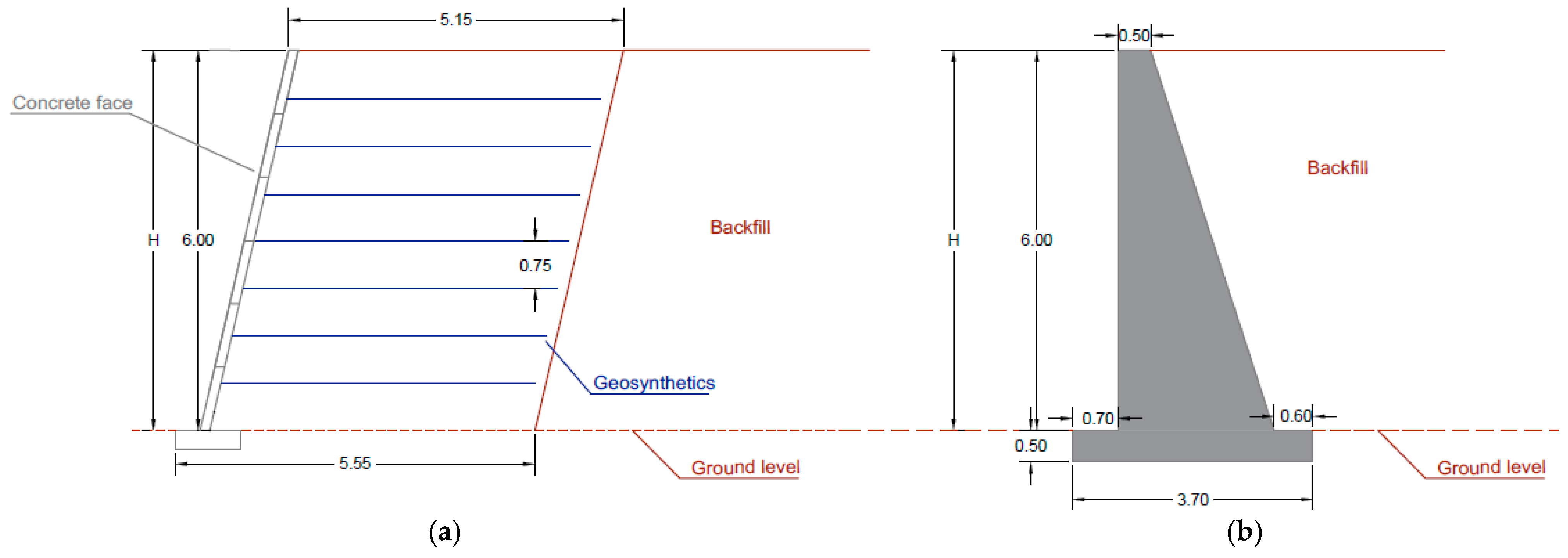
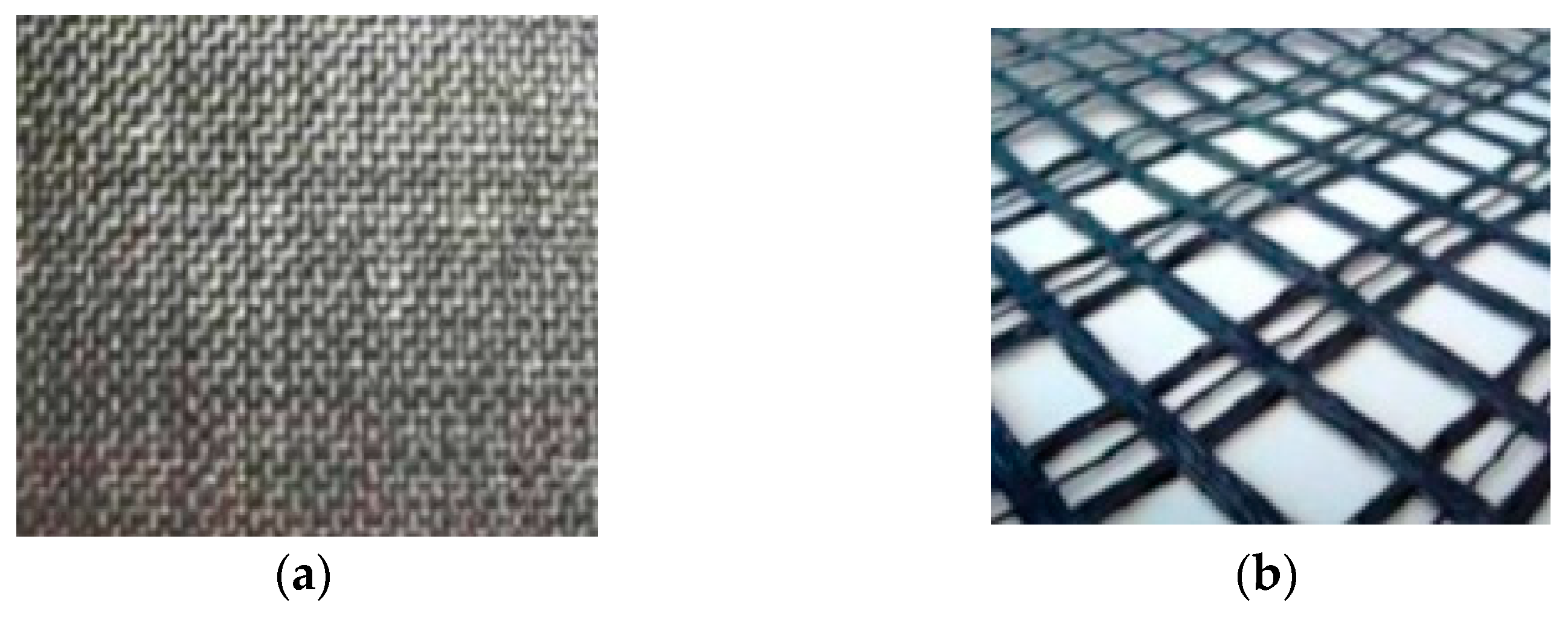

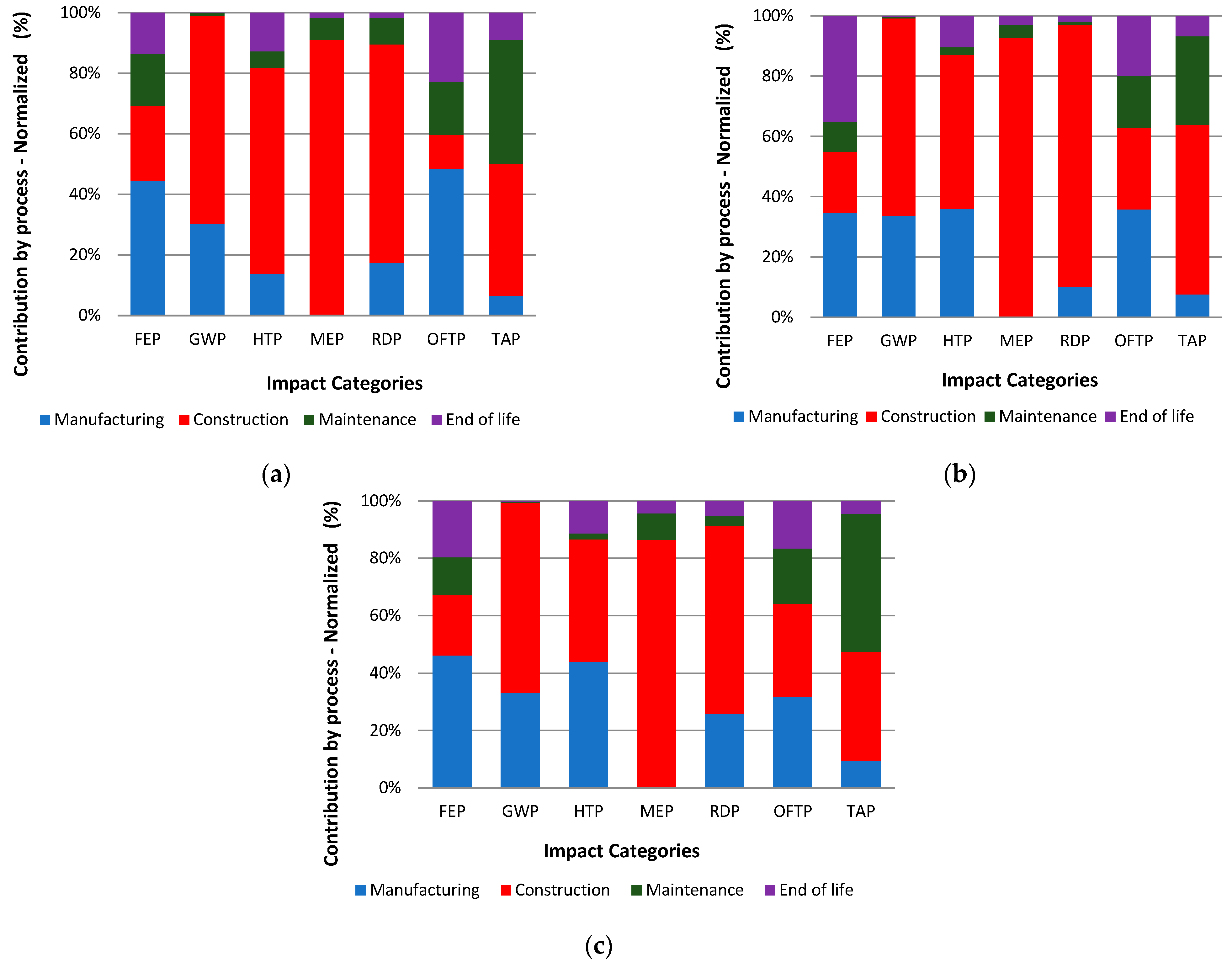
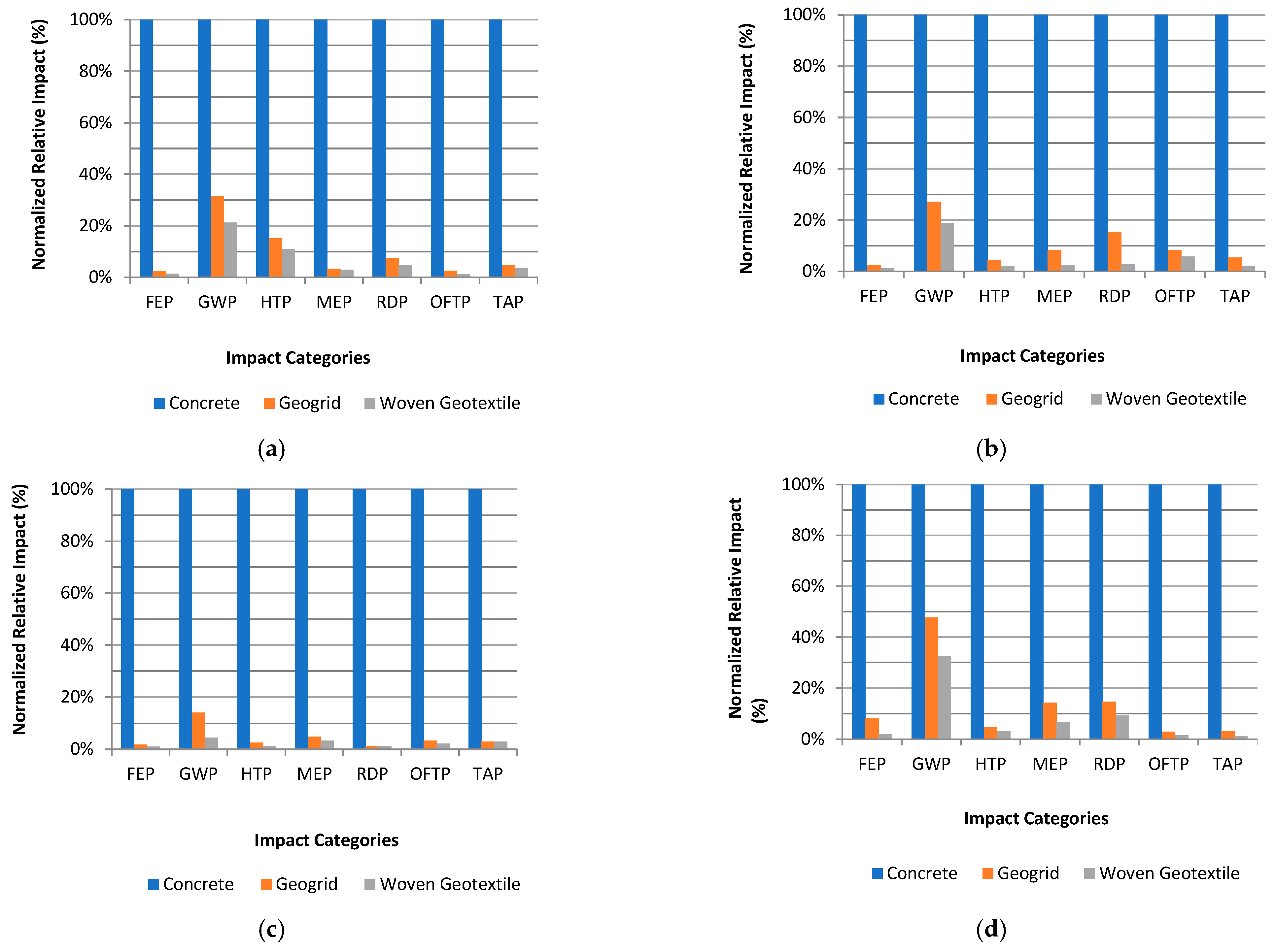
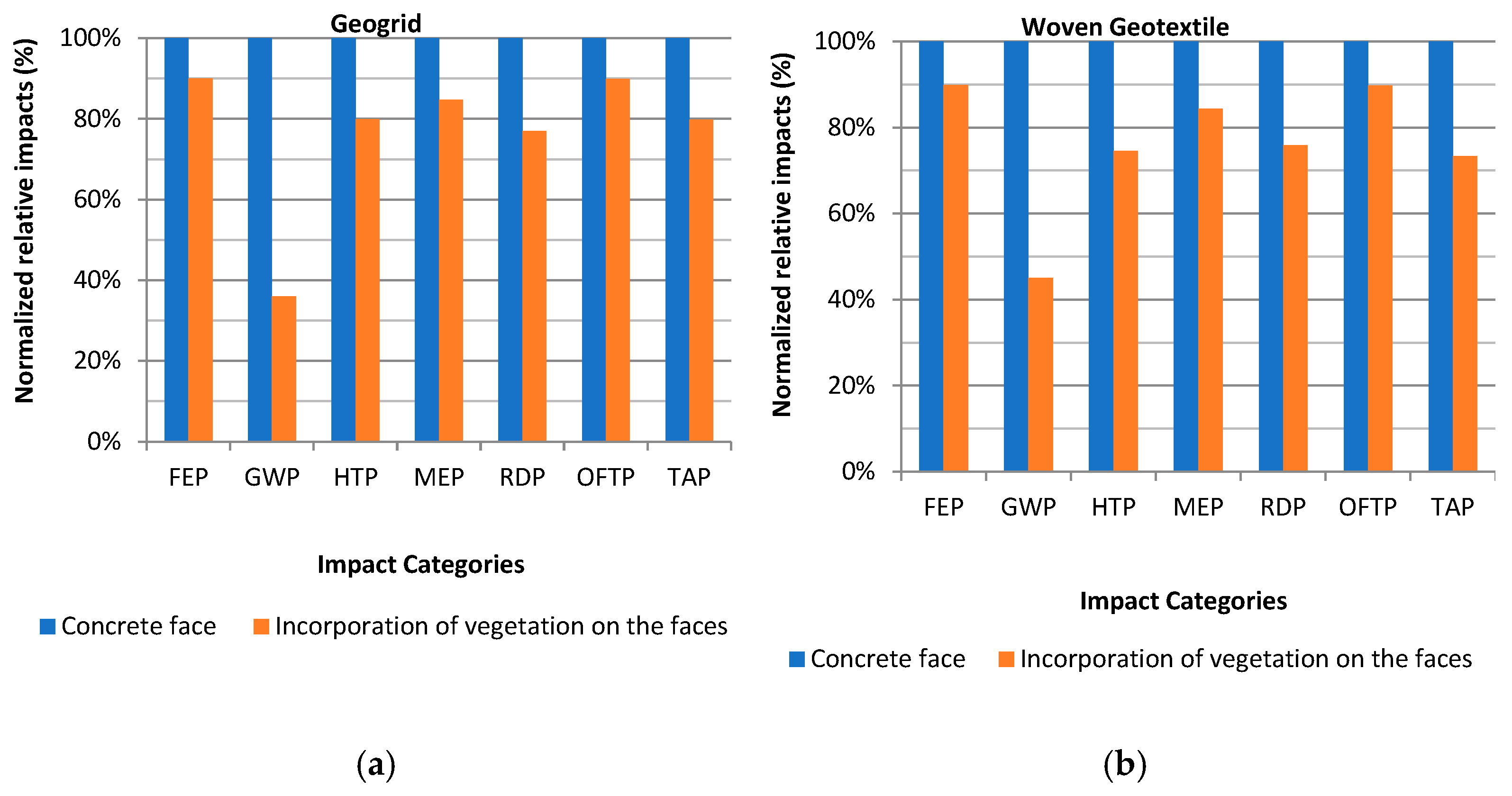


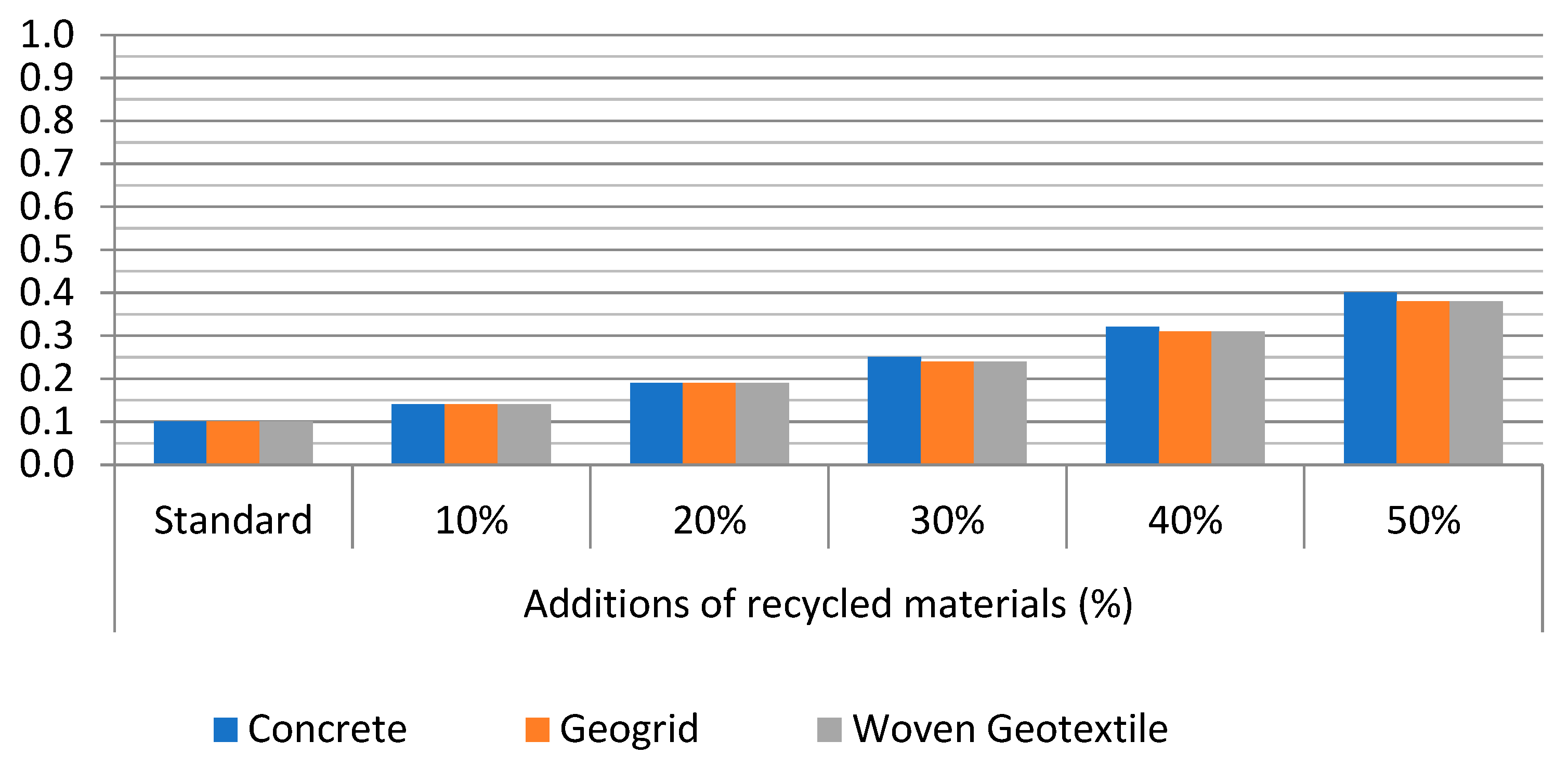
| Material | Units | Concrete | Geogrid | Woven Geotextile |
|---|---|---|---|---|
| Raw material | kg | 1.1 | 1.01 | 1.05 |
| Superplasticizer additive | kg | 0.0011 | - | - |
| Water | kg | 0.072 | 0.90 | 1.1 |
| Electricity | kwh | 1.1 | 0.80 | 0.85 |
| Diesel Machinery | L | 0.2 | 0.15 | 0.18 |
| Use of the factory for production | m2 | 8 × 10−4 | 5 × 10−4 | 5 × 10−4 |
| Waste generated after manufacturing | kg | 0.11 | 0.50 | 0.50 |
| Transport | tkm | 0.09 | 0.29 | 0.30 |
| Material | Units | Concrete | Geogrid | Woven Geotextile |
|---|---|---|---|---|
| Concrete | kg | 2400 | - | - |
| Concrete Ballast | kg | - | 120 | 120 |
| Electricity | kWh | 200 | 150 | 150 |
| Stone | kg | 1100 | 1100 | 1100 |
| Tubing | m | 3 | 1.8 | 1.8 |
| Diesel | L | 50 | 250 | 250 |
| Geosynthetics | kg | - | 19.6 | 8.82 |
| Wood | kg | 30 | 7 | 7 |
| Excavation of the base | kg | 1800 | 300 | 300 |
| Base compaction | h | 0.9 | 0.15 | 0.15 |
| Layer compaction | h | - | 1.2 | 1.2 |
| Installation of geosynthetics | h | - | 0.4 | 0.6 |
| Water | kg | 170 | 260 | 260 |
| Face coating | kg | - | 240 | 240 |
| Coating Installation | h | - | 0.04 | 0.04 |
| Waterproofing (Bitumen) | kg | 3.5 | - | - |
| Land Use | m2 | 0.9 | 0.5 | 0.5 |
| Waste generated after construction | kg | 360 | 5 | 5 |
| Transport | tkm | 744.64 | 147.83 | 147.82 |
| Material | Units | Concrete | Geogrid | Woven Geotextile |
|---|---|---|---|---|
| Concrete | kg | 200 | - | - |
| Electricity | kWh | 15 | 10 | 10 |
| Water | kg | 13 | 5 | 5 |
| Diesel for Machinery | L | 5 | 3 | 3 |
| Wood | kg | 5 | - | - |
| Geosynthetics | m2 | - | - | - |
| Face coating | kg | - | 120 | 120 |
| Soil compaction | h | 0.9 | 0.6 | 0.6 |
| Waste generated after maintenance | kg | 15 | 3 | 3 |
| Transport | tkm | 5.81 | 3.68 | 3.68 |
| Impact Category | Unit | Acronym Reference |
|---|---|---|
| Freshwater Eutrophication Potential | kg P eq | FEP |
| Human Toxicity Potential | kg 1.4-DCB | HTP |
| Global Warming Potential | kg CO2 eq | GWP |
| Marine Eutrophication Potential | kg N eq | MEP |
| Ozone Formation Terrestrial Potential | kg NOx eq | OFTP |
| Terrestrial Acidification Potential | kg SO2 eq | TAP |
| Resource Depletion Potential | kg Cu eq | RDP |
| Acronym Reference | Unit | Normalization Factor |
|---|---|---|
| FEP | kg P eq | 6.49 × 10−1 |
| HTP | kg 1.4-DCB | 1.49 × 1013 |
| GWP | kg CO2 eq | 7.99 × 1014 |
| MEP | kg N eq | 4.61 × 1014 |
| OFTP | kg NOx eq | 1.78 × 1014 |
| TAP | kg SO2 eq | 4.10 × 1013 |
| RDP | kg Cu eq | 1.20 × 1014 |
| Material | Components | Additions of Recycled Material | ||||
|---|---|---|---|---|---|---|
| 10 (%) | 20 (%) | 30 (%) | 40 (%) | 50 (%) | ||
| (%) | (%) | (%) | (%) | (%) | ||
| Recycled material before period of use (%) | Concrete with virgin materials | 90 | 80 | 70 | 60 | 50 |
| Recycled concrete | 10 | 20 | 30 | 40 | 50 | |
| Geogrid with virgin materials | 90 | 80 | 70 | 60 | 50 | |
| Geogrid with recycled materials | 10 | 20 | 30 | 40 | 50 | |
| Geotextile fabric with virgin materials | 90 | 80 | 70 | 60 | 50 | |
| Geotextile fabric with recycled materials | 10 | 20 | 30 | 40 | 50 | |
| Recycled material after period of use (%) | Concrete with virgin materials | 90 | 80 | 70 | 60 | 50 |
| Recycled concrete | 10 | 20 | 30 | 40 | 50 | |
| Geogrid with virgin materials | 90 | 80 | 70 | 60 | 50 | |
| Geogrid with recycled materials | 10 | 20 | 30 | 40 | 50 | |
| Geotextile fabric with virgin materials | 90 | 80 | 70 | 60 | 50 | |
| Geotextile fabric with recycled materials | 10 | 20 | 30 | 40 | 50 | |
| ERW in Concrete | ||||
|---|---|---|---|---|
| Impact Category | Manufacturing | Construction | Maintenance | End-of-life |
| FEP | 3.37 × 10−16 | 1.89 × 10−16 | 1.29 × 10−16 | 1.04 × 10−16 |
| HTP | 9.94 × 10−1 | 2.26 × 100 | 3.04 × 10−2 | 6.70 × 10−3 |
| GWP | 4.68 × 10−4 | 2.30 × 10−3 | 1.84 × 10−4 | 4.34 × 10−4 |
| MEP | 4.65 × 10−8 | 2.25 × 10−4 | 1.80 × 10−5 | 4.24 × 10−6 |
| OFTP | 8.28 × 10−5 | 3.44 × 10−4 | 4.16 × 10−5 | 8.37 × 10−6 |
| TAP | 4.69 × 10−17 | 1.08 × 10−17 | 1.70 × 10−17 | 2.22 × 10−17 |
| RDP | 1.45 × 10−4 | 9.85 × 10−4 | 9.23 × 10−4 | 2.05 × 10−4 |
| MSE with Geogrid | ||||
| Impact Category | Manufacturing | Construction | Maintenance | End-of-life |
| FEP | 8.36 × 10−18 | 4.86 × 10−18 | 2.38 × 10−18 | 8.47 × 10−18 |
| HTP | 3.14 × 10−1 | 6.13 × 10−1 | 4.27 × 10−3 | 3.19 × 10−3 |
| GWP | 7.04 × 10−5 | 9.98 × 10−5 | 4.86 × 10−6 | 2.04 × 10−5 |
| MEP | 1.57 × 10−9 | 1.88 × 10−5 | 8.81 × 10−7 | 6.03 × 10−7 |
| OFTP | 6.18 × 10−6 | 5.28 × 10−5 | 5.31 × 10−7 | 1.22 × 10−6 |
| TAP | 1.19 × 10−18 | 8.97 × 10−19 | 5.75 × 10−19 | 6.61 × 10−19 |
| RDP | 7.07 × 10−6 | 5.27 × 10−5 | 2.75 × 10−5 | 6.32 × 10−6 |
| MSE with Woven Geotextile | ||||
| Impact Category | Manufacturing | Construction | Maintenance | End-of-life |
| FEP | 4.80 × 10−18 | 2.19 × 10−18 | 1.38 × 10−18 | 2.04 × 10−18 |
| HTP | 2.12 × 10−1 | 4.24 × 10−1 | 1.37 × 10−3 | 2.17 × 10−3 |
| GWP | 5.15 × 10−5 | 5.03 × 10−5 | 2.49 × 10−6 | 1.33 × 10−5 |
| MEP | 1.36 × 10−9 | 5.64 × 10−6 | 6.10 × 10−7 | 2.82 × 10−7 |
| OFTP | 3.87 × 10−6 | 9.82 × 10−6 | 5.31 × 10−7 | 7.70 × 10−7 |
| TAP | 6.10 × 10−19 | 6.24 × 10−19 | 3.75 × 10−19 | 3.20 × 10−19 |
| RDP | 5.43 × 10−6 | 2.16 × 10−5 | 2.75 × 10−5 | 2.58 × 10−6 |
| ERW in Concrete | ||||
| Impact Category | Manufacturing | Construction | Maintenance | End-of-life |
| FEP | 5.19 × 10−16 | 2.92 × 10−16 | 1.98 × 10−16 | 1.61 × 10−16 |
| HTP | 1.24 × 10−15 | 2.83 × 10−15 | 3.81 × 10−17 | 8.39 × 10−18 |
| GWP | 3.14 × 10−17 | 1.54 × 10−16 | 1.24 × 10−17 | 2.91 × 10−17 |
| MEP | 1.01 × 10−22 | 4.89 × 10−19 | 3.90 × 10−20 | 9.21 × 10−21 |
| OFTP | 6.90 × 10−19 | 2.87 × 10−18 | 3.47 × 10−19 | 6.97 × 10−20 |
| TAP | 2.64 × 10−31 | 6.10 × 10−32 | 9.59 × 10−32 | 1.25 × 10−31 |
| RDP | 3.54 × 10−18 | 2.40 × 10−17 | 2.25 × 10−17 | 4.99 × 10−18 |
| MSE with Geogrid | ||||
| Impact Category | Manufacturing | Construction | Maintenance | End-of-life |
| FEP | 1.29 × 10−17 | 7.49 × 10−18 | 3.67 × 10−18 | 1.30 × 10−17 |
| HTP | 3.94 × 10−16 | 7.67 × 10−16 | 5.35 × 10−18 | 4.00 × 10−18 |
| GWP | 4.72 × 10−18 | 6.70 × 10−18 | 3.26 × 10−19 | 1.37 × 10−18 |
| MEP | 3.40 × 10−24 | 4.08 × 10−20 | 1.91 × 10−21 | 1.31 × 10−21 |
| OFTP | 5.15 × 10−20 | 4.40 × 10−19 | 4.42 × 10−21 | 1.02 × 10−20 |
| TAP | 6.70 × 10−33 | 5.05 × 10−33 | 3.23 × 10−33 | 3.72 × 10−33 |
| RDP | 1.73 × 10−19 | 1.29 × 10−18 | 6.71 × 10−19 | 1.54 × 10−19 |
| MSE with Woven Geotextile | ||||
| Impact Category | Manufacturing | Construction | Maintenance | End-of-life |
| FEP | 7.40 × 10−18 | 3.37 × 10−18 | 2.13 × 10−18 | 3.14 × 10−18 |
| HTP | 2.65 × 10−16 | 5.30 × 10−16 | 1.72 × 10−18 | 2.71 × 10−18 |
| GWP | 3.46 × 10−18 | 3.38 × 10−18 | 1.67 × 10−19 | 8.91 × 10−19 |
| MEP | 2.96 × 10−24 | 1.22 × 10−20 | 1.32 × 10−21 | 6.12 × 10−22 |
| OFTP | 3.23 × 10−20 | 8.18 × 10−20 | 4.42 × 10−21 | 6.41 × 10−21 |
| TAP | 3.43 × 10−33 | 3.51 × 10−33 | 2.11 × 10−33 | 1.80 × 10−33 |
| RDP | 1.33 × 10−19 | 5.26 × 10−19 | 6.71 × 10−19 | 6.30 × 10−20 |
Disclaimer/Publisher’s Note: The statements, opinions and data contained in all publications are solely those of the individual author(s) and contributor(s) and not of MDPI and/or the editor(s). MDPI and/or the editor(s) disclaim responsibility for any injury to people or property resulting from any ideas, methods, instructions or products referred to in the content. |
© 2025 by the authors. Licensee MDPI, Basel, Switzerland. This article is an open access article distributed under the terms and conditions of the Creative Commons Attribution (CC BY) license (https://creativecommons.org/licenses/by/4.0/).
Share and Cite
Araújo Junior, L.P.V.d.; Bueno, C.; Silva, J.L.d. Life Cycle Assessment and Circularity Indicators of Earth-Retaining Walls and Mechanically Stabilized Earth. Sustainability 2025, 17, 3769. https://doi.org/10.3390/su17093769
Araújo Junior LPVd, Bueno C, Silva JLd. Life Cycle Assessment and Circularity Indicators of Earth-Retaining Walls and Mechanically Stabilized Earth. Sustainability. 2025; 17(9):3769. https://doi.org/10.3390/su17093769
Chicago/Turabian StyleAraújo Junior, Luiz Paulo Vieira de, Cristiane Bueno, and Jefferson Lins da Silva. 2025. "Life Cycle Assessment and Circularity Indicators of Earth-Retaining Walls and Mechanically Stabilized Earth" Sustainability 17, no. 9: 3769. https://doi.org/10.3390/su17093769
APA StyleAraújo Junior, L. P. V. d., Bueno, C., & Silva, J. L. d. (2025). Life Cycle Assessment and Circularity Indicators of Earth-Retaining Walls and Mechanically Stabilized Earth. Sustainability, 17(9), 3769. https://doi.org/10.3390/su17093769








